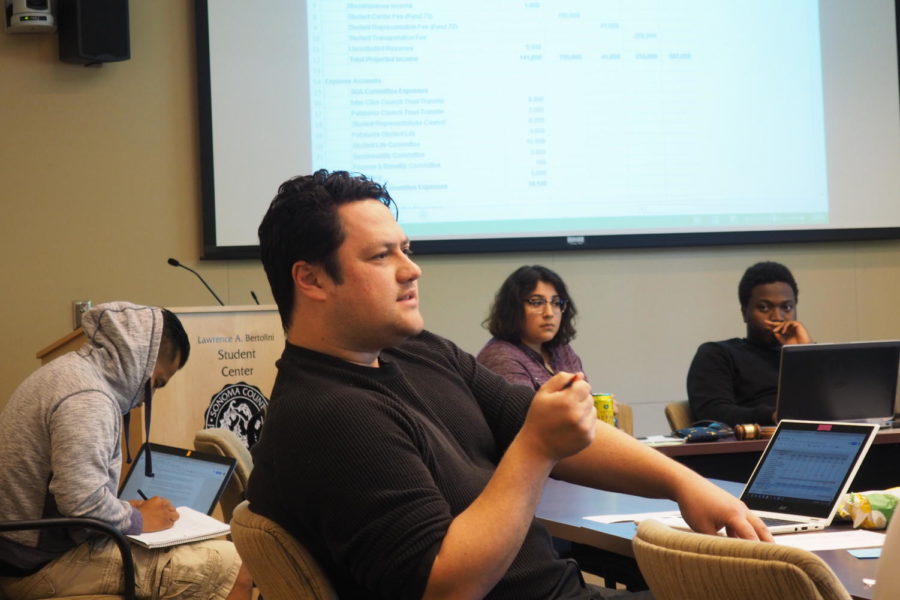The months-long deal to purchase $5,000 of advertising space from The Oak Leaf met resistance from some student representatives as the Santa Rosa Junior College Student Government Assembly (SGA) works to create its 2018-2019 budget Monday.
Oak Leaf adviser Anne Belden, student government representatives and advisers and Dean of Student Life Robert Ethington planned the deal as a way to allocate money to the underfunded student newspaper while promoting the CubCard+ and avoiding conflicts of interest.
Belden said she returned from sabbatical this year with a $20,000 deficit. The Oak Leaf is the only self-supporting student newspaper in the California community college system; all other papers receive funding directly from the school.
Current SGA President Evelyn Navarro said, “The intention behind those funds would be to purchase ads in order to promote SGA and support another organization on campus.”
Members disagreed on where the money should come from and if it should be given to the student newspaper directly or used for advertising and marketing in general.
President-elect Eduardo Osório Juárez said he would be more comfortable if the money were allocated to general ads, not just for the student newspaper.
Juárez said, “I’m going to be working with this budget next year and I definitely want to develop those relationships differently and not just put some expectations out there. So their not gonna just think like, ‘This is our money.’”
He said he was unsure of what his student government’s relationship will be with the paper.
“I want to utilize The Oak Leaf resources as well, while funding them, but again I also want to be cautious with that relationship. I don’t know where that relationship lies with The Oak Leaf—it’s always up in the air right?”
Juárez said the budget in question will be for his administration next year, and proposed allocating the money to SGA’s own student life and marketing committees.
“Using those two resources can be beneficial, and eventually this money could end up in The Oak Leaf, but I wanna give more creativity in connecting other departments with the marketing department before our professionals who can teach this to them,” Juárez said.
A motion by the future president to remove the funding was defeated in a roll call vote 4-3.
Inter-Club Council Chair Joshua Pinaula, who worked closely with Belden and the paper’s ad manager, said the deal would be mutually beneficial.
“During my entire time here we’ve never figured out marketing—ever. I think it’s a systemic problem that can’t be solved within us.” Pinaula said, “We don’t have the answer, or else we would have done it for years and we have just chosen not to do it, year after year.”
He said The Oak Leaf already had a marketing model and relationships with the community the SGA could use to market the CubCard+. The ICC purchased ad space in the paper’s centennial issue.
“Look what we’ve done, and look what they’ve done. All the things that have happened throughout the year, it can be arguable that they’ve done more—visually—for the student body, than we have,” Pinaula said.
“We’ve done a lot behind the scenes, but out there, covering those stories about the fire, covering the stories about AFA and Eric Thompson—they’ve had more of a presence, and more people are aware of them than they are of us. Effectively they are doing a better job.”
Pinaula advocated the money go directly to The Oak Leaf, rather than to the marketing budget as Juárez proposed, provided the funding be conditional on increased CubCard+ revenue.
He said if The Oak Leaf “[doesn’t] produce anything, then [it’s] not gonna get anything.”
Dori Elder, vice president of student life, agreed SGA should give $5,000 from reserves to fund The Oak Leaf directly, and not committees.
“If we’re gonna do that $5,000 from reserves, then I think it should just go to The Oak Leaf—they’re also an award-winning paper and I believe they deserve the money,” Elder said.
The proposed funding for The Oak Leaf would represent .9 percent against the SGA’s $573,000 2017-18 budget and 12.5 percent of the $40,000 unspent reserves money.





